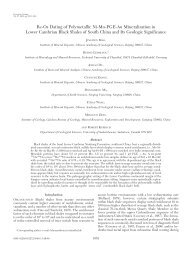Uranium Ore Deposits
Uranium Ore Deposits
Uranium Ore Deposits
Create successful ePaper yourself
Turn your PDF publications into a flip-book with our unique Google optimized e-Paper software.
EDUCATION<br />
Such nuclear energy systems are set to play a key role in a<br />
sustainable long-term world energy balance.<br />
There is currently a boom in uranium exploration, with a<br />
global expenditure of about 720 million USD in 2007 for exploration<br />
and mine development (Fig. 1), still much below<br />
the exploration budgets in the late 1970s.<br />
Natural uranium consists essentially of two isotopes, 238 U<br />
with an abundance of 99.3 % and 235 U with an abundance<br />
of 0.7 % which slowly decay to 206 Pb and 207 Pb, respectively<br />
(T ½ 238 U 4.5 Ga; T ½ 235 U 710 Ma). Only 235 U can be used in conventional<br />
fission reactors, and most reactors (Light Water<br />
Reactors) use enriched uranium where the proportion of<br />
the 235 U isotope has been increased from the present-day<br />
natural composition at 0.7 % to about 3 % or up to 5 % (for<br />
comparison, uranium used for nuclear weapons has to<br />
be enriched to at least 90 % 235 U). The world consumption<br />
of uranium (non-enriched) for the<br />
total of 439 operating reactors<br />
(September 2008) is about 65,000 t U<br />
per year from which 2600 TWh (1 TWh =<br />
1 billion kWh) electricity are generated,<br />
equivalent of 16 % of total world<br />
electricity generation.<br />
nuclear plants, as well as an expansion of up to 80 %<br />
expected by 2030, although supply shortfalls could develop<br />
given the long lead time typically required to bring new<br />
resources into production, and given the long period of<br />
stagnation of the uranium market at very low uranium prices<br />
in the recent past, which were insufficient to sustain<br />
investment in exploration and development. Deployment of<br />
advanced reactor and fuel cycle technology could extend<br />
the long-term availability of nuclear energy from a century<br />
to thousands of years. Such technology would use fast<br />
neutrons which are able to fission 238 U, and therefore use<br />
the other 99.3 % of natural uranium which are currently<br />
wasted or stockpiled.<br />
The mine production of uranium<br />
in 2007 is shown in Figure 2, with<br />
Canada (23 %), Australia (21 %) and<br />
Kazakhstan (16 %) standing out.<br />
Germany contributed 0.1 % from<br />
treatment of mine waters from former<br />
uranium mining areas in eastern<br />
Germany. Historically, eastern Germany<br />
and the Czech Republic during<br />
the times of the GDR and Czechoslovakia,<br />
respectively, were significant<br />
providers for the Soviet nuclear arsenal.<br />
There is a difference between<br />
uranium demand (65,000 t/yr) and<br />
mine production (41,300 t/yr) which<br />
is covered from the large military<br />
inventories of the USA and Russia,<br />
and from recycling of nuclear waste<br />
(Fig. 3)<br />
The currently identified uranium<br />
resources are adequate<br />
to meet the requirements during<br />
the lifetime of the current<br />
Fig. 2:<br />
Present-day and historical<br />
world uranium mine production..<br />
Issue 02 | 2008<br />
www.advanced-mining.com<br />
17










